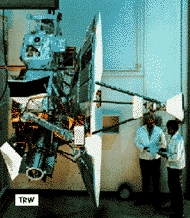Pioneer 10, 11
Part of the Pioneer program
 Pioneers 10 and 11 were the first spacecraft to visit Jupiter (Pioneer 10 and 11) and Saturn (Pioneer 11 only). Acting as pathfinders for the Voyager missions, the vehicles provided the first up-close science observations of these planets, as well as information about the environments that would be encountered by the Voyagers. Instruments aboard the two craft studied Jupiter and Saturn's atmospheres, magnetic fields, moons, and rings, as well as the interplanetary magnetic and dust particle environement, the solar wind, and cosmic rays. Following their planetary encounters, the vehicles continued on escape trajectories from the solar system.
At the end of 1995, Pioneer 10 (the first man-made object to leave the solar system) was about 64 AU from the Sun and heading toward interstellar space at 2.6 AU/year. At the same time Pioneer 11 was 44.7 AU from the Sun and heading outward at 2.5 AU/year. Following their planetary encounters, some
experiments aboard both spacecraft were turned off to save power as the vehicle's RTG power output degraded. Pioneer 11's mission ended on September 30, 1995 when its RTG power level was insufficient to operate any
experiments and the spacecraft could no longer be controlled. Pioneer 10 is expected to operate until sometime in 1997 when its power levels are also expected to fall below the minimum required levels. Both spacecraft carry a plaque with a drawing depicting a man, woman, and the location of the sun and
earth in the galaxy as greetings to any extraterrestrials who may find the vehicles.
Pioneers 10 and 11 were the first spacecraft to visit Jupiter (Pioneer 10 and 11) and Saturn (Pioneer 11 only). Acting as pathfinders for the Voyager missions, the vehicles provided the first up-close science observations of these planets, as well as information about the environments that would be encountered by the Voyagers. Instruments aboard the two craft studied Jupiter and Saturn's atmospheres, magnetic fields, moons, and rings, as well as the interplanetary magnetic and dust particle environement, the solar wind, and cosmic rays. Following their planetary encounters, the vehicles continued on escape trajectories from the solar system.
At the end of 1995, Pioneer 10 (the first man-made object to leave the solar system) was about 64 AU from the Sun and heading toward interstellar space at 2.6 AU/year. At the same time Pioneer 11 was 44.7 AU from the Sun and heading outward at 2.5 AU/year. Following their planetary encounters, some
experiments aboard both spacecraft were turned off to save power as the vehicle's RTG power output degraded. Pioneer 11's mission ended on September 30, 1995 when its RTG power level was insufficient to operate any
experiments and the spacecraft could no longer be controlled. Pioneer 10 is expected to operate until sometime in 1997 when its power levels are also expected to fall below the minimum required levels. Both spacecraft carry a plaque with a drawing depicting a man, woman, and the location of the sun and
earth in the galaxy as greetings to any extraterrestrials who may find the vehicles.
Spacecraft
Spin stabilized at ~5 rpm. Four SNAP-19 RTGs provided 155W (BOL). Attitude controlled by direction finding on communications radio beam. Hexagonal structure of aluminum with boron-epoxy tubes. Hydrazine propulsion with 6 x 1-lbf thrusters. 40 AHr AgCd battery. 49 kbits data storage. 2.74 m dia. parabolic HGA, medium gain and low gain antennas provide S-band communications from 2048 to 16 bps through NASA DSN stations. Deployable 6.6 m boom for magnetometer. One star (Canopus) sensor
and two sun sensors for attitude knowledge.
Payload
Instruments carried included a magnetometer, plasma analyzer, charged particle detector, ionizing detector, non-imaging telescopes with overlapping fields of view to detect sunlight reflected from passing meteoroids, micrometeoroid detectors, UV photometer, IR radiometer, and an imaging photopolarimeter.
The spacecrafts' radio systems were also used to perform radio science. Pioneer 11 also carried a low-sensitivity fluxgate magnetometer.
| Country of Origin | United States |
| Customer/User | NASA, Ames Research Center |
| Manufacturer(s) | TRW |
| Size | 9 ft. diameter antenna |
| Orbit | 10: Solar system escape trajectory. Jupiter closest approach of ~200000 km on December 3, 1973 / 11: Solar system escape trajectory. Jupiter closest approach of 34000 km on December 4, 1974. Saturn closest approach of 21000 km on September 1, 1979. |
| Design Life | 2.5 years |
| Related Sites | Pioneer Home Page at Ames |
Launch Facts
| Name | Int'l Desig. | Date | Site | Vehicle | Orbit | Mass(kg) |
| Notes | ||||||
| Pioneer 10 | 1972-012A | 3/3/72 | ESMC | Atlas Centaur | SSET | 259 |
| Jupiter flyby 12/73; 1st man-made object to leave solar system. Operations were discontinued on 3/31/97 because of power limitations. Spacecraft continues its voyage into deep space. | ||||||
| Pioneer 11 | 1973-019A | 4/6/73 | ESMC | Atlas Centaur | SSET | 259 |
| Jupiter flyby 12/74; Saturn flyby 9/1/79 | ||||||
Information in The Mission and Spacecraft Library is provided without warranty or guarantee. USE AT YOUR OWN RISK.